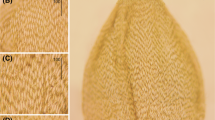Abstract
Plectranthus bishopianus has recently been treated as a synonym of Plectranthus deccanicus. However, a detailed study of the type materials, recently collected specimens, as well as SEM analysis of pollen and mericarp of both species suggests that P. bishopianus is a distinct species. The specific status of P. bishopianus is thus reinstated, and it can be easily distinguished from P. deccanicus by the stem nature, leaf size and shape, cyme length, number of flowers per cyme, the structure of flowering and fruiting calyx and mericarp surface. Additionally, complete taxonomic descriptions, photographs and conservation assessments, along with notes on distribution and habitat of both species, are provided.




Similar content being viewed by others
References
Bentham G (1831) Plectranthus. In: Wallich N (ed) Plantae Asiaticae Rariores. Treuttel & Würtz, London, pp 16–18. https://doi.org/10.5962/bhl.title.468
Bentham G (1832) Labiatarum genera et species. James Ridgway & sons, London
Bentham G (1848) Labiatae. In: de Candolle AP (ed) Prodromous systematis naturalis regni vegetabilis. Treuttel et Würtz, Paris, pp 55–70. https://doi.org/10.5962/bhl.title.286
Budantsev AV, Lobova TA (1997) Fruit morphology, anatomy and taxonomy of tribe Nepeteae (Labiatae). Edinb J Bot 54:183–216. https://doi.org/10.1017/S0960428600004029
Cramer LH (1978) A revision of Coleus (Labiatae) in Sri Lanka (Ceylon). Kew Bull 32:551–561
Gamble JS (1921) Labiatae. Flora of the Presidency of Madras, vol. 2. Adlard & Sons Ltd., London, pp 1106–1159
Gamble JS (1924) Decades Kewenses. Plantarum novarum in herbario Horti Regii conservatarum. Bull Misc Inform Kew 1924:264–265
Govaerts R, Paton AJ, Harvey Y, Navarro T, Peña M del RG (2017) World checklist of Lamiaceae. Facilitated by the Royal Botanic Gardens, Kew. Available at: http://apps.kew.org/wcsp/. Accessed 12 Aug 2017
Harley MM, Paton AJ, Harley RM, Cade PG (1992) Pollen morphological studies in tribe Ocimeae (Nepetoideae: Labiatae): 1. Ocimum L. Grana 31:161–176. https://doi.org/10.1080/00173139209432027
Harley RM, Atkins S, Budantsev AL, Cantino PD, Conn BJ, Grayer R, Harley MM, Kok R, Krestovskaja T, Morales R, Paton AJ, Ryding O, Upson T (2004) Labiatae. In: Kadereit JW (ed) Families and Genera of vascular plants, vol. VII. Springer, Berlin, pp 167‒275
Henry AN, Kumari GR, Chithra V (1987) Flora of Tamil Nadu. Botanical Survey of India, Coimbatore
Hooker JD (1885) Labiatae. In: The Flora of British India, vol. 4. L. Reeve & Co., London, pp 604‒705
IUCN (2012) IUCN red list categories and criteria, version 3.1. IUCN Species Survival Commission, Gland, Switzerland and Cambridge
Karuppuswamy S, Rajasekharan KM (2009) Rediscovery of an extinct plant (Plectranthus bishopianus) from Tamil Nadu, after a century. Curr Sci 3:293
Lukhoba CW, Simmonds MSJ, Paton AJ (2006) Plectranthus: a review of ethnobotanical uses. J Ethnopharmacol 10:1–24. https://doi.org/10.1016/j.jep.2005.09.011
Matthew KM (1993) Precursory notes for a flora of the Palni hills, South India: II. Kew Bull 48:757–765
Mathew J, Yohannan R, Conn BJ (2017) Three new species of Plectranthus (Lamiaceae) from south Western Ghats, India. Telopea 20:177–189
Moon HK, Hong SP, Smets E, Huysmans S (2009) Micromorphology and character evolution of nutlets in tribe Mentheae (Nepetoideae, Lamiaceae). Syst Bot 34:760–776. https://doi.org/10.1600/036364409790139592
Mukerjee SK (1940) A revision of Labiatae of Indian Empire. Rec Bot Surv India 14:1–228
Nayar MP, Sastry ARK (1990) Red data book of Indian plants. BSI, Kolkata
Paton AJ, Springate D, Suddee S, Otieno D, Grayer RJ, Harley MM, Willis F, Simmonds MSJ, Powell MP (2004) Phylogeny and evolution of basils and allies (Ocimeae, Labiatae) based on three plastid DNA regions. Molec Phylogen Evol 31:279–299
Punt W, Hoen PP, Blackmore S, Nilsson S, Thomas AL (2007) Glossary of pollen and spore terminology. Rev Palaeobot Palynol 143:181. https://doi.org/10.1016/j.revpalbo.2006.06.008
Rice LJ, Brits GJ, Potgieter CJ, Van Staden J (2011) Plectranthus: a plant for the future? S African J Bot 77:947–959. https://doi.org/10.1016/j.sajb.2011.07.001
Ryding O (1993) A reconsideration of the genus Rabdosiella (Lamiaceae, Nepetoideae, Ocimeae). Pl Syst Evol 185:91–97
Sharma BD, Singh NP, Raghavan RS, Deshpande UR (1984) Flora of Karnataka analysis. Botanical Survey of India, Kolkata
Smitha K, Sunojkumar P (2015) Notes on the Identity and distribution of Plectranthus subincisus (Lamiaceae)—a poorly known species recollected after 150 years in southern India. Phytotaxa 192:105–111. https://doi.org/10.11646/phytotaxa.192.2.3
Smitha K, Sunojkumar P (2016) Plectranthus anamudianus (Lamiaceae): a new species from Western Ghats, India. Phytotaxa 284:51–60. https://doi.org/10.11646/phytotaxa.284.1.5
Suddee S, Paton AJ, Parnell JAN (2004) A taxonomic revision of tribe Ocimeae Dumort. (Lamiaceae) in continental South East Asia II. Plectranthinae. Kew Bull 59:379–414
Acknowledgements
The authors are grateful to the Forest Department, Kerala State, for permission to undertake field studies in protected areas. We are grateful to curators of CAL, CALI, JCB, FRLH, K, KFRI, MH, RHT and TBGT. We would like to thank Gurukula Botanical Sanctuary assistance in collection of plant specimens. KS thanks Kerala State Council for Science, Technology & Environment, Government of Kerala, for the research fellowship and PS thanks the Department of Biotechnology (BT/PR5423/BCE/8/907/2012), Government of India, for the financial support.
Author information
Authors and Affiliations
Corresponding author
Ethics declarations
Conflict of interest
The authors declare that they have no conflict of interest.
Additional information
Handling editor: Jürg Schönenberger.
Rights and permissions
About this article
Cite this article
Smitha, K., Paton, A. & Sunojkumar, P. Re-establishment of Plectranthus bishopianus (Lamiaceae) based on morphological and micromorphological data. Plant Syst Evol 304, 807–816 (2018). https://doi.org/10.1007/s00606-018-1511-6
Received:
Accepted:
Published:
Issue Date:
DOI: https://doi.org/10.1007/s00606-018-1511-6




